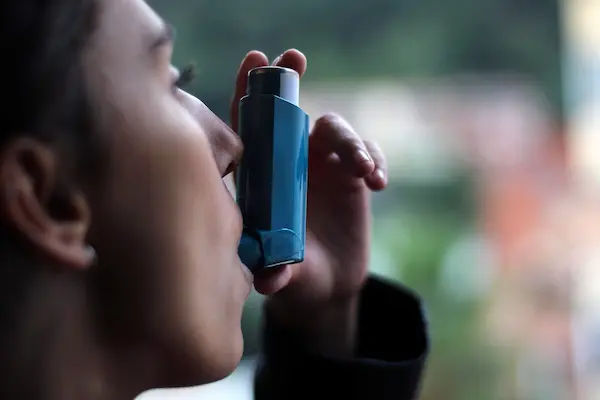Breathe Easy: Your Comprehensive Guide to Understanding and Managing Asthma Introduction
Know about the asthma, what it is, causes, risks, symptoms, diagnosis, treatment options and living well with the asthma and more.

Written by Dr. Shaik Abdul Kalam
Reviewed by Dr. D Bhanu Prakash MBBS, AFIH, Advanced certificate in critical care medicine, Fellowship in critical care medicine
Last updated on 9th Oct, 2025

Imagine trying to breathe through a narrow, sticky straw while someone sits on your chest. For millions of people with asthma, this feeling of air hunger is a frightening reality during a flare-up. Asthma is a common chronic condition that affects the airways in your lungs, but it's far from a simple diagnosis. It's a variable and personal journey, with triggers and symptoms that differ for everyone. Whether you've just been diagnosed, suspect you might have asthma, or are caring for someone who does, understanding the condition is the first step toward taking control. This guide will demystify asthma, explaining everything from its underlying causes and common symptoms to the most effective modern treatments and daily management strategies. Our goal is to empower you with knowledge, so you can breathe easier and live a full, active life without fear.
What is Asthma, Exactly? The Basics of a Chronic Lung Condition
At its core, asthma is a chronic inflammatory disease of the airways. Think of your airways (bronchial tubes) as branches of an upside-down tree inside your lungs. In a person with asthma, these branches are chronically inflamed and sensitive, or "twitchy." This means they overreact to things that wouldn't bother most people's lungs.
When exposed to a trigger, three key things happen inside the airways:
1. Inflammation: The lining of the airways becomes swollen and irritated.
2. Bronchoconstriction: The muscles surrounding the airways tighten, squeezing them and making them narrower.
3. Mucus Production: The airways produce excess thick mucus, further clogging the already narrowed passages.
This combination makes it extremely difficult for air to flow in and out, leading to the classic symptoms of an asthma attack.
Consult a Top Lung Specialist for Personalised Advice
How do Your Airways Behave During an Asthma Attack?
During a calm breath, your airways are open and relaxed. But during an asthma attack, the inflammation worsens, the muscle bands tighten significantly, and mucus plugs the tubes. This results in wheezing (a whistling sound when you breathe), chest tightness, and coughing as your body struggles to move air. Understanding this mechanism is crucial because it directly informs the treatment: we need medicines that reduce inflammation (long-term control) and medicines that relax the tight muscles (quick relief).
Recognising the Signs: Common and Not-So-Common Asthma Symptoms
Asthma symptoms can range from a minor nuisance to life-threatening. They also tend to come and go, often worsening at night or in the early morning. Recognising them early is key to preventing a full-blown attack.
The most common asthma symptoms include:
Wheezing: A high-pitched whistling sound when you breathe out.
Shortness of breath: Feeling like you can't get enough air, even when resting.
Chest tightness: A feeling of pressure or squeezing in your chest.
Coughing: A persistent cough, which may be worse at night or after exercise. For some, a chronic cough is the primary symptom ("cough-variant asthma").
Symptoms of an Asthma Attack in Adults
An asthma attack is a sudden worsening of symptoms. Signs that indicate a serious attack requiring immediate medical attention include:
Symptoms that continue to worsen even after using a rescue inhaler.
Severe shortness of breath that makes it hard to talk, eat, or sleep.
Rapid breathing and a racing heart.
Lips or fingernails turning blue or grey (a sign of oxygen deprivation).
Childhood Asthma Symptoms: What Parents Need to Watch For
Childhood asthma can be tricky, as symptoms often mimic a cold or bronchitis. Parents should be alert if their child has frequent coughing spells that worsen with viral infections, during play, or while laughing. Listen for wheezing or whistling sounds when they exhale, and watch for complaints of chest tightness or shortness of breath. Fatigue caused by poor sleep due to coughing or breathing difficulty is another red flag. If you notice these patterns, it's important to consult a paediatrician for an evaluation.
The Culprits Behind the Cough: Unpacking Asthma Causes and Triggers
While the exact cause of asthma is not fully understood, it's believed to result from a combination of genetic and environmental factors. If you have a family history of asthma or allergies, your risk is higher. However, exposure to certain substances can trigger symptoms in those who already have sensitive airways.
Common Allergens That Can Worsen Asthma
For many, asthma is allergy-induced. The immune system overreacts to harmless substances, triggering an asthma response. Common allergens include:
Airborne allergens: Pollen from trees, grasses, and weeds, dust mites, pet dander (from cats and dogs), mould spores, and cockroach droppings.
Non-Allergic Triggers: Irritants and Environmental Factors
Not all triggers are allergic. Other irritants can inflame the airways directly:
Respiratory infections: Colds, flu, and sinus infections are common triggers.
Physical activity: Exercise-induced bronchoconstriction can cause symptoms during or after exertion.
Cold air or weather changes.
Air pollutants and irritants: Tobacco smoke, vehicle exhaust, smoke from fires, and strong chemical fumes (perfumes, cleaning products).
Strong emotions: Stress, laughter, or crying can sometimes trigger hyperventilation and symptoms.
Getting a Diagnosis: How Doctors Confirm You Have Asthma
If you experience recurring breathing problems, a doctor can perform a diagnosis for asthma. This typically involves a review of your medical and family history, a physical exam (listening to your breathing), and lung function tests. If your symptoms persist beyond two weeks, consult a doctor online with Apollo24|7 for an initial evaluation and to discuss if further testing is needed.
Common Asthma Tests and What to Expect
Lung function tests are the gold standard for diagnosing asthma because they measure how well your lungs are working.
Spirometry Test
This is the most common test. You'll take a deep breath and then blow out as hard and fast as you can into a tube connected to a spirometer. The machine measures how much air you can exhale in one second (FEV1) and the total amount you can exhale (FVC). The doctor may have you repeat the test after using a bronchodilator (a quick-relief inhaler) to see if your lung function improves.
Peak Flow Measurement
A peak flow meter is a small, handheld device you can use at home to monitor your asthma. It measures how fast you can blow air out of your lungs. A low peak flow reading can be an early warning sign of worsening asthma, even before you feel symptoms.
Your Asthma Toolkit: Effective Treatment and Management Strategies
Modern asthma treatment is highly effective and focuses on two main goals: controlling chronic inflammation and providing quick relief during flare-ups. Your treatment plan will be personalised, often involving a combination of approaches.
Quick-Relief Medications (Rescue Inhalers)
These are used as needed for immediate relief of asthma symptoms or before exercise if recommended by your doctor. They work by quickly relaxing the tightened muscles around your airways. The most common type is a short-acting beta-agonist (like albuterol). Important: Needing your rescue inhaler more than twice a week is a sign that your asthma is not well controlled.
Long-Term Control Medications (Preventive Treatments)
These are the cornerstones of asthma management for most people. Taken daily, they reduce underlying inflammation and prevent symptoms from occurring. The most common are inhaled corticosteroids. Other options include long-acting bronchodilators, combination inhalers, and leukotriene modifiers.
The Importance of an Asthma Action Plan
Every person with asthma should have a written Asthma Action Plan created with their doctor. This plan is your personalised guide, detailing:
What medicines to take daily?
How to recognise when your symptoms are worsening (using peak flow zones: green, yellow, red).
What steps to take and what medicines to use during a flare-up.
When to seek emergency medical help.
Living Well with Asthma: Lifestyle Tips for Prevention and Control
Beyond medication, lifestyle choices play a huge role in managing asthma. Key strategies include:
Identify and Avoid Triggers: Keep a diary to track your symptoms and potential triggers. This is the most powerful step you can take.
Get Vaccinated: Flu and pneumonia vaccines can prevent illnesses that trigger asthma attacks.
Create an Asthma-Friendly Home: Use allergen-proof mattress and pillow covers, wash bedding weekly in hot water, vacuum regularly with a HEPA filter, and maintain low humidity to reduce dust mites and mould.
Stay Active: Regular exercise strengthens your breathing muscles. Manage exercise-induced symptoms by using your rescue inhaler before activity as prescribed.
Monitor Your Breathing: Regular use of a peak flow meter can help you catch a flare-up early.
Conclusion
Living with asthma requires awareness and proactive management, but it should not define or limit your life. By understanding what asthma is, learning to recognise your unique symptoms and triggers, and partnering with your healthcare provider to create a solid treatment plan, you can take full control of your respiratory health. The goal is not just to treat attacks but to prevent them from happening in the first place. Remember, effective management is a continuous journey. Stay informed, adhere to your prescribed treatments, and don't hesitate to communicate openly with your doctor about any changes in your condition. With the right knowledge and tools, you can breathe easy and confidently pursue your daily activities.
Consult a Top Lung Specialist for Personalised Advice
Consult a Top Lung Specialist for Personalised Advice

Dr. Sumara Maqbool
Pulmonology Respiratory Medicine Specialist
12 Years • MBBS, DNB Respiratory, critical care and sleep medicine, DrNB superspeciality Critical care, IDCCM, IFCCM, EDIC
Delhi
Apollo Hospitals Indraprastha, Delhi
(25+ Patients)

Dr Rakesh Bilagi
Pulmonology Respiratory Medicine Specialist
10 Years • MBBS MD PULMONOLOGIST
Bengaluru
Apollo Clinic, JP nagar, Bengaluru
Dr. Preeti Kathail
General Physician/ Internal Medicine Specialist
17 Years • MBBS, PGDHHM
Bangalore
Apollo Clinic Bellandur, Bangalore

Dr. Chaithanya R
Internal Medicine Specialist Diabetologist
16 Years • MBBS, MD Internal Medicine, Fellowship in Diabetes(UK), CCEBDM(PHFI)
Bangalore
Apollo Clinic Bellandur, Bangalore
(75+ Patients)

Dr Vishwa Vijeth K.
Pulmonology Respiratory Medicine Specialist
8 Years • MBBS, MD ( Respiratory Medicine)
Bangalore
Apollo Clinic Bellandur, Bangalore




